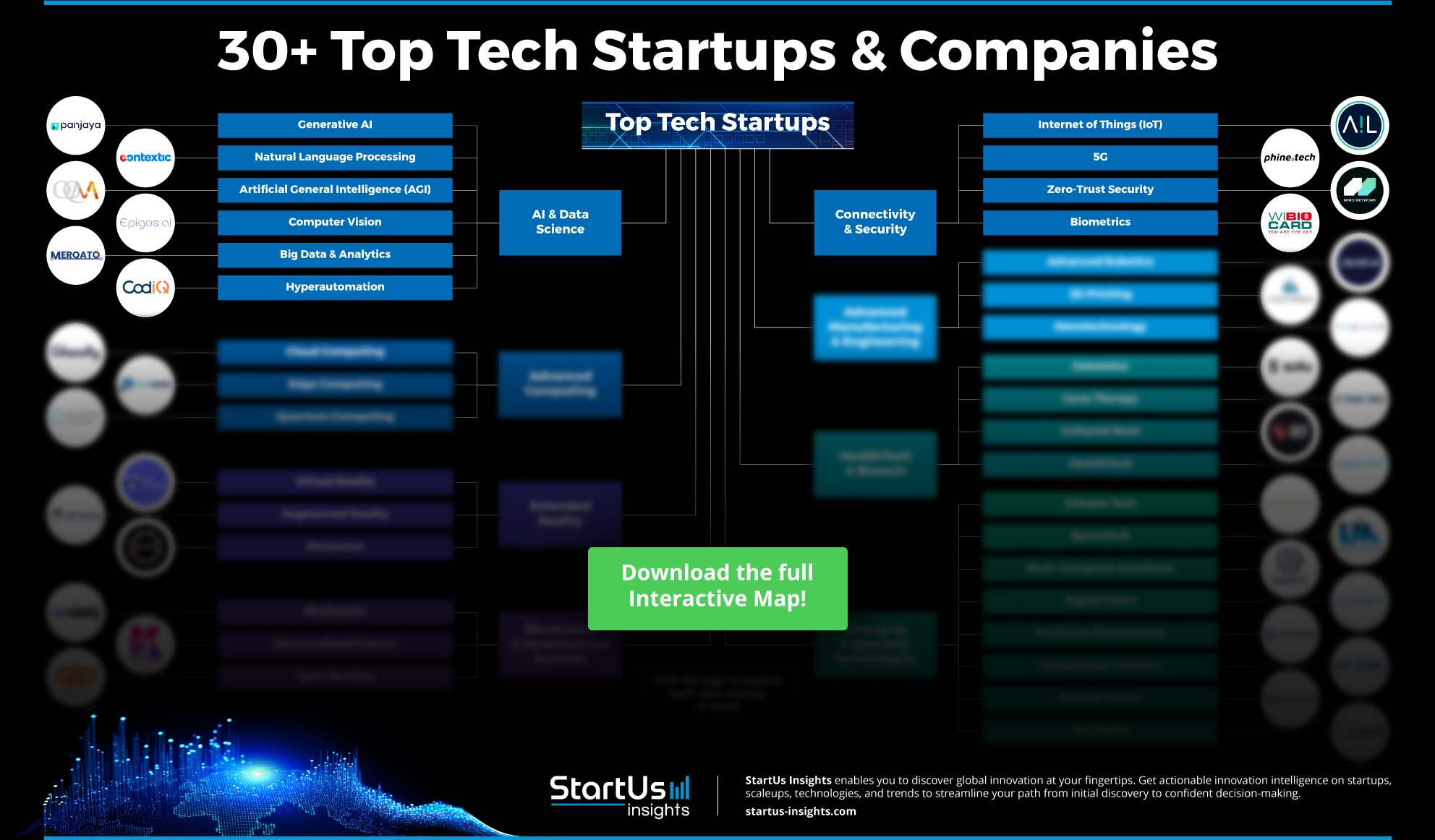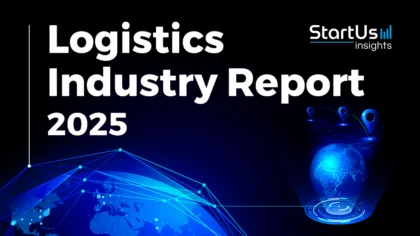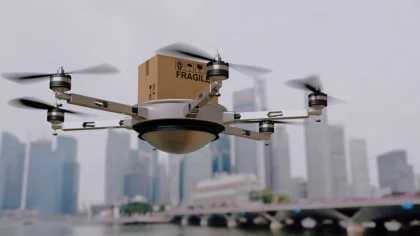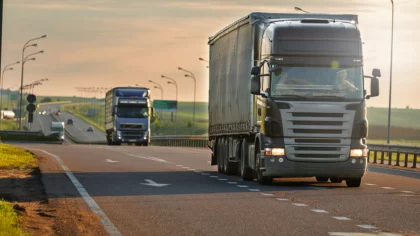Advances in logistics technology are addressing pressing industry challenges and streamlining operational efficiency. Developments in artificial intelligence (AI), robotics, and virtual reality (VR) are particularly impactful. For example, AI-powered automation enhances productivity, and VR-based platforms improve workforce training and safety. Further, AI-driven robots, like those developed by Anyware Robotics, streamline complex tasks such as box unloading. Whereas, VR training solutions, from companies like Hard Hat VR, ensure logistics teams are better equipped for real-world challenges.
These developments underscore the urgency for industry stakeholders to embrace new technologies to maintain competitiveness. As logistics increasingly integrates biometrics, Internet of Things (IoT), blockchain, and more, staying ahead of these innovations is essential. This report provides critical insights into the technologies shaping the future of logistics in 2025 and beyond, guiding industry leaders through this rapidly evolving landscape.
Why should you read this report?
- Gain insights into the top 10 technologies impacting logistics.
- Learn about three practical use cases for each technology.
- Meet 10 innovative startups advancing these technologies.

Key Takeaways
- Artificial Intelligence
- Use Cases:
- Route Optimization
- Demand Forecasting
- Automated Warehouse Management
- Startup to Watch: Everest AI
- Use Cases:
- Advanced Robotics
- Use Cases:
- Robotic Delivery Systems
- AMRs for Inventory Management
- Automated Sorting & Packaging
- Startup to Watch: Anyware Robotics
- Use Cases:
- CleanTech
- Use Cases:
- Green Transportation & Vehicles
- Energy-Efficient Warehouses
- Sustainable Packaging
- Startup to Watch: GRYN
- Use Cases:
- Internet of Things
- Use Cases:
- Fleet Management & Tracking
- Smart Warehouses
- Supply Chain Monitoring
- Startup to Watch: FOSSA
- Use Cases:
- Blockchain
- Use Cases:
- Transparent Supply Chain Management
- Immutable Record-Keeping
- Smart Contracts for Shipping
- Startup to Watch: Supplain
- Use Cases:
- Cloud Computing
- Use Cases:
- Supply Chain Optimization
- Real-Time Tracking & Monitoring
- Remote Asset Tracking
- Startup to Watch: ESTOKO Logistics
- Use Cases:
- Big Data & Analytics
- Use Cases:
- Supply Chain Optimization
- Real-Time Tracking & Analytics
- Inventory Forecasting
- Startup to Watch: Logiam
- Use Cases:
- Augmented Reality (AR) & Virtual Reality
- Use Cases:
- Staff Training
- Loading & Unloading Visualization
- Route Planning
- Startup to Watch: Hard Hat VR
- Use Cases:
- Biometrics
- Use Cases:
- Access Control
- Driver Identification
- Attendance Tracking
- Startup to Watch: Liber Health
- Use Cases:
- Connectivity Technologies
- Use Cases:
- Connected Fleet Management
- Real-Time Goods Tracking
- Cross-Docking Operation Management
- Startup to Watch: Hubble Network
- Use Cases:
Logistics Industry FAQs
How technology is changing the future of logistics?
Advanced technologies like AI, IoT, and blockchain are automating logistics processes, enhancing real-time data analytics, and securing supply chains. AI optimizes routing and demand forecasting, IoT enables precise asset tracking, and blockchain ensures immutable data records, collectively increasing efficiency, reducing operational costs, and improving supply chain transparency.
What is the next big wave is logistics technology?
Autonomous vehicles and drones are set to transform logistics, particularly in last-mile delivery. Autonomous trucks optimize long-haul efficiency and safety, while drones expedite urban deliveries. Concurrently, machine learning and predictive analytics will optimize resource allocation to drive more precise demand forecasting and operational efficiency across logistics networks.
What are the new trends in logistics?
Key trends include sustainability through electric vehicles (EVs) and green warehousing, big data-driven optimization in inventory and routing, and enhanced customer experiences via AI-powered personalization. These innovations collectively improve operational efficiency, reduce environmental impact, and elevate customer satisfaction through faster, more transparent, and tailored logistics services.
Read more on this: Explore the Top 10 Logistics Trends in 2025!
How many logistics companies are in the world?
According to Discovery Platform, a comprehensive startup database, there are over 148,900 logistics companies, ranging from small businesses to large multinationals. On average, these companies employ about 47 people.
How We Identify Emerging Technologies & Startups
The data in this report originates from StartUs Insights’ Discovery Platform, covering 4.7 million global startups, scaleups, and technology companies, alongside 20,000 emerging technology trends. Our platform makes startup and technology scouting, trend intelligence, and patent searches more efficient by providing deep insights into the technological ecosystem. Utilizing the trend intelligence feature, we analyze industry-specific technologies for this report, detect patterns and trends, and identify use cases along with the startups advancing these areas. Further details and capabilities are accessible via the website.
10 Emerging Technologies Impacting the Future of Logistics
1. Artificial Intelligence

AI is enhancing how companies manage supply chains, forecast demand, and streamline logistics operations. It analyzes extensive datasets, leading to more precise demand predictions and real-time decision-making. This empowers logistics companies to anticipate market shifts, optimize delivery routes, and enhance resource allocation, resulting in more adaptive supply chains. Additionally, AI-driven automation such as advanced robotics and autonomous vehicles is minimizing reliance on manual labor, improving accuracy, and scaling operations to meet dynamic business needs.
3 Practical Use Cases of AI in the Logistics
- Route Optimization: By analyzing traffic patterns, weather conditions, and delivery constraints, AI identifies the most efficient routes, reducing fuel consumption, delivery times, and operational costs. This dynamic approach enables logistics companies to ensure optimal resource utilization and minimize delays.
- Demand Forecasting: Machine learning algorithms analyze vast datasets to predict future demand patterns. By processing historical sales data, seasonal trends, and external factors like economic indicators, AI optimizes inventory management and distribution planning. This reduces stockouts, minimizes overstock, and enhances supply chain efficiency.
- Automated Warehouse Management: AI predicts demand, reduces errors, and automates repetitive tasks like inventory tracking and order fulfillment. This results in increased efficiency, reduced operational costs, and improved scalability.
Startup to Watch: Everest AI
US-based startup Everest AI streamlines logistics operations by optimizing email workflows for brokers, carriers, and 3PLs. The startup’s AI-driven platform integrates with existing transport management systems (TMS), electronic logging devices (ELD), and load boards. It then connects email systems to operational platforms and automatically prioritizes critical information for quoting shipments and accelerating routine tasks. The platform’s AI assistant further enables faster customer responses, efficient bid processing, and fraud detection. The platform also provides insights into win/loss ratios, customer prioritization, and team performance. This way, it automates order entry, reduces response times, and enhances operational efficiency for logistics teams.
2. Advanced Robotics

Autonomous mobile robots (AMRs) and robotic picking systems are simplifying warehouse management by automating sorting, packing, and retrieval while reducing human error. These intelligent systems, powered by AI and machine learning, enable more agile and responsive logistics operations. As companies increasingly adopt robotics, they gain a competitive advantage through optimized workflows, reduced operational costs, and improved service delivery.
3 Practical Use Cases of Robotics in Logistics
- Robotic Delivery Systems: Autonomous vehicles and drones optimize last-mile logistics by navigating complex urban environments. They use machine learning and sensor fusion to adapt to dynamic conditions and reduce delivery times.
- AMRs for Inventory Management: These robots optimize space utilization, reduce manual labor, and improve accuracy by integrating with warehouse management systems. AMRs also leverage sensors, AI-driven navigation, and real-time data analytics to autonomously locate, track, and transport inventory.
- Automated Sorting & Packaging: These systems leverage robotics integrated with machine vision, deep learning algorithms, and high-precision actuators to execute complex sorting and packaging tasks with accuracy and speed. They automate traditionally labor-intensive processes, reducing error rates and boosting throughput.
Startup to Watch: Anyware Robotics
Anyware Robotics is a US-based startup that develops Pixmo, an AI-powered mobile robot that autonomously unloads boxes from containers and trucks. Pixmo integrates an AMR base with a collaborative robot arm that features six degrees of freedom and a vacuum-powered end effector to manage the complexities of box unloading. Its proprietary embodied AI enables real-time adaptation to various box sizes, orientations, and conditions during transit, ensuring precision and productivity in transload facilities and distribution centers..
3. CleanTech

The logistics sector, responsible for approximately 24% of global CO2 emissions, is under increasing pressure to adopt decarbonization strategies. CleanTech innovations, such as the adoption of electric vehicles (EVs) and alternative fuels, are playing a pivotal role in reducing the environmental impact of logistics operations. Companies are also developing zero-emission transport refrigeration units powered by solar energy and battery technology to optimize cold chains. These advancements not only contribute to sustainability goals but also offer operational cost savings and improved efficiency, making them an attractive option for logistics providers.
3 Practical Use Cases of CleanTech in Logistics
- Green Transportation & Vehicles: Electric trucks, hydrogen fuel cells, and regenerative braking systems are central to green logistics. Advanced telematics integrates with these technologies to optimize route planning, monitor real-time energy usage, and manage battery life cycles.
- Energy-Efficient Warehouses: Smart HVAC systems, LED lighting, and energy management software reduce energy consumption in warehouses. Sensors and IoT devices also optimize temperature, humidity, and lighting in real time to streamline energy use.
- Sustainable Packaging: Biodegradable materials, advanced recycling techniques, and lightweight designs reduce waste and energy consumption required for packages in the logistics sector.
Startup to Watch: GRYN
GRYN is a German startup that designs a carbon visibility and collaboration platform for the logistics sector. It automates the collection of Scope 3 emissions data from diverse supply chain sources via API integrations or manual uploads. The platform also ensures data accuracy and regulatory compliance by engaging suppliers in a validation process aligned with standards like CSRD, ESRS, ISO 14083, and the GHG Protocol. Further, it offers advanced analytics tools to convert raw emissions data into actionable insights, enabling logistics companies and service providers to set and achieve reduction targets.
4. Internet of Things

IoT enables real-time tracking and monitoring of assets, vehicles, and goods to increase visibility and control across logistics operations. By integrating sensors, RFID tags, and GPS trackers into logistics operations, companies monitor shipment location, condition, and status to transport goods under optimal conditions, particularly in cold chain logistics. Moreover, IoT platforms facilitate data collection and analysis for predictive maintenance and efficient route planning. This, in turn, reduces operational costs and enhances overall efficiency.
3 Practical Use Cases of IoT in Logistics
- Fleet Management & Tracking: IoT-powered fleet management and tracking systems streamline logistics by monitoring real-time vehicle location, fuel consumption, and driver behavior. Integrated GPS and telematics further optimize routes, reduce idle time, and enhance fuel efficiency.
- Smart Warehouses: Connected warehouses feature real-time inventory tracking, predictive maintenance, and optimized storage to communicate data across the supply chain to monitor goods, reduce errors, and accelerate order fulfillment.
- Supply Chain Monitoring: End-to-end visibility into supply chains using sensors and GPS devices allows companies to predict disruptions, optimize routes, and ensure regulatory compliance. This improves decision-making, minimizes delays, and mitigates operational risks.
Startup to Watch: FOSSA
Based out of Spain, FOSSA makes the FOSSA XL, a satellite IoT device that enables remote monitoring and control of assets for the logistics sector. FOSSA XL features multiple interfaces, connectivity options, and mounting solutions. It acts as a communication hub, collecting and processing data from IoT devices not initially equipped for satellite connectivity, and transmitting critical information via satellite or cellular networks. Additionally, the device supports various sensors, allowing logistics operators to monitor key environmental parameters such as humidity, temperature, and CO2 levels in real time.
5. Blockchain

By creating immutable records of every transaction and movement within a supply chain, blockchain ensures that each step is verifiable. Thus, significantly reducing fraud and errors. This enhanced traceability is crucial in complex logistics networks where the accurate tracking of goods from origin to destination is essential. Further, blockchain smart contracts automate financial transactions to minimize delays and administrative overhead associated with cross-border payments. This accelerates customs clearance and delivery times and also reduces costs, making logistics operations more efficient.
3 Practical Use Cases of Blockchain in Logistics
- Transparent Supply Chain Management: Blockchain provides a decentralized ledger that records every transaction and movement of goods. The tech ensures traceability, verifies the authenticity of products, and eliminates fraud by creating a single source of truth accessible to all stakeholders.
- Immutable Record-Keeping: Blockchain stores data in a decentralized ledger that is tamper-proof and transparent. Each transaction is cryptographically secured, ensuring data integrity and traceability across the supply chain. This immutable record prevents fraud, supports regulatory compliance, and enhances auditability in supply chains.
- Smart Contracts for Shipping: Executes predefined conditions on a blockchain to ensure secure, real-time transactions. These self-executing contracts streamline payments, trigger automated actions like cargo release, and enforce compliance, reducing delays and errors.
Startup to Watch: Supplain
Estonian startup Supplain uses blockchain to advance data management for logistics service providers. The platform standardizes data exchange format across the logistics sector, enabling companies to integrate with Supplain’s blockchain rather than maintaining multiple disparate IT systems. This integration reduces the redundancy of building custom systems and lowers IT costs. It also features W3C verifiable credentials and decentralized identifiers (DIDs) to increase security and trust. The platform automates the establishment of partnerships and agreements between companies to streamline logistical processes and reduce errors.

6. Cloud Computing

Cloud-based platforms enable logistics providers to access and analyze data from IoT devices for precise shipment tracking. They optimize route planning and automate inventory management across global supply chains. Cloud computing also centralizes data to break down silos and facilitate collaboration across the logistics ecosystem. Thus, stakeholders, from suppliers to distributors, are able to share information and coordinate more effectively.
3 Practical Use Cases of Cloud Computing in Logistics
- Supply Chain Optimization: Cloud computing provides scalable platforms for real-time data processing and advanced analytics. It allows the integration of logistics data, predictive modeling, and demand forecasting, improving decision-making and inventory management.
- Real-Time Tracking & Monitoring: Such solutions process and analyze vast amounts of location and sensor data to deliver continuous visibility of shipments. This allows for immediate response to disruptions, optimizing efficiency and security.
- Remote Asset Tracking: By processing real-time data from IoT devices, cloud-based platforms enable remote asset tracking. It supports precise location tracking and condition monitoring to ensure efficient asset utilization and enhanced control.
Startup to Watch: ESTOKO Logistics
ESTOKO Logistics is a Spanish startup that automates warehousing and logistics deployment through its cloud-based platform. It reduces the need for businesses to maintain their own warehousing facilities by linking them to specialized warehouses with available capacity. The platform offers integration of storage, fulfillment, and distribution services to increase operational efficiency while lowering logistics costs. The platform’s key features include real-time inventory management, automated deployment, and flexible warehousing.
7. Big Data & Analytics

Big data utilizes vast amounts of data from various sources, such as shipment tracking, warehouse operations, and customer interactions. This enables logistics providers to discover hidden patterns and trends that enhance the accuracy of demand forecasting and inventory management. This predictive capability allows companies to anticipate supply chain disruptions, optimize resource allocation, and reduce operational costs. Moreover, Big data enables real-time visibility into logistics operations, offering actionable insights that improve route planning, fleet management, and overall supply chain transparency. Advanced analytics also play a crucial role in automating labor management, optimizing workforce deployment during peak periods, and reducing inefficiencies.
3 Practical Use Cases of Big Data & Analytics in Logistics
- Supply Chain Optimization: Big data and analytics solutions uncover patterns, predict demand, and optimize routes for precise decision-making and continuous adjustment of logistics processes. This improves the efficiency and adaptability of supply chains.
- Real-Time Tracking & Analytics: Provide detailed insights into goods movement and conditions for logistics operators to monitor assets continuously and respond dynamically to any disruptions.
- Inventory Forecasting: Logistics operators leverage predictive analytics to analyze historical sales data, market trends, and real-time demand signals to improve inventory forecasting. Advanced algorithms predict future inventory needs to optimize stock levels and reduce overstocking.
Startup to Watch: Logiam
Brazilian startup Logiam offers a suite of analytics solutions to optimize logistics operations. Its process mining tool utilizes big data to visualize actual process flows, identify bottlenecks, and reduce processing times. Whereas, the logistics network optimization solution uses big data optimization algorithms to determine the best locations for logistics facilities. It includes geo-analytics visualization, and mapping logistics networks with detailed location data. Lastly, the dashboards enable logistics managers to monitor critical KPIs in real-time through a web and mobile platform, featuring predictive analytics and risk management.
8. Augmented Reality & Virtual Reality

AR enables logistics operators to overlay digital information onto the physical environment. This facilitates real-time guidance for inventory management, order picking, and equipment maintenance. The technology streamlines operations by reducing errors, optimizing warehouse layouts, and accelerating training processes for new employees. VR, on the other hand, creates immersive simulations for training, allowing workers to experience and practice complex scenarios in a risk-free environment. This is beneficial for driver training and remote collaboration, where VR simulates real-world challenges like vehicle inspections or emergency situations without physical presence.
3 Practical Use Cases of AR & VR in Logistics
- Staff Training: AR and VR create immersive, simulated environments to deliver hands-on training for equipment handling and warehouse navigation while providing real-time feedback.
- Loading & Unloading Visualization: Immersive technologies provide detailed visualizations for loading and unloading, integrating real-time spatial data with virtual environments. This allows workers to see the exact placement and alignment of goods before execution, ensuring precision and coordination.
- Route Planning: AR and VR enhance route planning by simulating and visualizing complex logistics networks in immersive 3D environments. This enables the analysis of traffic patterns, terrain, and potential obstacles.
Startup to Watch: Hard Hat VR
Based out of the US, Hard Hat VR is a startup that offers a VR-powered training platform to enhance workforce skills in logistics. The platform simulates real-world warehouse environments for employees to engage in immersive training sessions. They cover critical tasks such as warehouse hazard awareness, picking, forklift inspection, and packing procedures, among others. The VR platform thus enables logistics teams to practice and refine their skills in a safe, controlled setting, reducing the risk of accidents and improving operational efficiency.
9. Biometrics

By leveraging fingerprints, facial recognition, and iris scans, logistics companies enable secure and accurate identity verification throughout the supply chain. This is beneficial in areas such as access control for sensitive logistics facilities, secure employee identification, and verification of driver identities during deliveries. Moreover, the integration of biometrics into logistics processes reduces the risk of fraud, improves the speed of operations, and enhances overall operational transparency.
3 Practical Use Cases of Biometrics in Logistics
- Access Control: Employing advanced fingerprint, facial, and iris recognition technologies to securely authenticate and monitor personnel enables real-time, tamper-proof verification and entry tracking to avoid unauthorized breaches.
- Driver Identification: Integration of fingerprint, facial, and iris recognition systems into vehicle access protocols enhances driver identification. This enhances security, enables precise tracking of driver behavior, and reduces the risk of unauthorized vehicle use.
- Attendance Tracking: Biometric solutions accurately record employee check-ins and check-outs in warehouses and other facilities. These solutions also integrate with workforce management systems to provide real-time data on employee presence and hours worked.
Startup to Watch: Liber Health
UAE-based startup Liber Health develops a contactless IRIS identification system. The company utilizes biometric scanning to authenticate individuals through a non-invasive process, ensuring secure access control in logistics environments. This system captures and analyzes unique iris patterns, which are then matched against a secure database to verify identity. Key features include high accuracy, quick processing times, and the ability to operate in various lighting conditions. This enhances security protocols while minimizing the risk of unauthorized access. By implementing this IRIS identification technology, Liber Health enables logistics companies to enhance security, streamline operations, and safeguard sensitive areas within their supply chain.
10. Connectivity Technologies

Connectivity technologies like 5G, Wi-Fi, and Ethernet advance logistics by enhancing communication, data transfer, and operational efficiency. Deploying 5G networks provides ultra-low latency and faster data speeds, and connects numerous devices simultaneously. This allows logistics companies to implement AR in warehouse operations and VR for remote training. Wi-Fi and Ethernet provide essential support within warehouses and distribution centers to facilitate stable and secure connections for real-time inventory tracking, automated systems, and communication between devices and platforms.
3 Practical Use Cases of Connectivity Technologies in Logistics
- Connected Fleet Management: Utilizing 5G and high-bandwidth Wi-Fi in fleet management enables real-time telemetry and predictive analytics. This allows precise tracking, adaptive route optimization, and integration with IoT sensors.
- Real-Time Goods Tracking: The high-speed, low-latency capabilities of 5G and GPS enable continuous, precise monitoring of shipments. This provides granular data on location, temperature, and goods conditions for real-time analytics.
- Cross-Docking Operation Management: 5G and Bluetooth-based solutions synchronize real-time data exchange between inbound and outbound logistics to minimize storage time and reduce handling costs. Advanced connectivity ensures precise tracking and coordination.
Startup to Watch: Hubble Network
US-based startup Hubble Network provides a Bluetooth-based fleet tracking solution. The company utilizes Bluetooth low energy (BLE) devices to monitor real-time fleet location and status. This enables logistics managers to gain precise insights into their operations. The BLE devices transmit location data to a central platform, where it is analyzed and displayed through a dashboard. Its features include low power consumption, easy integration with existing systems, and the ability to track vehicles in challenging environments. Hubble Network’s solution thus enables logistics companies to optimize fleet management, reduce operational costs, and improve efficiency.
Outlook for the Logistics Industry
Patents & Grants
The industry’s innovation is evident in filing over 31,000 patents, highlighting a strong focus on new technologies. The awarding of more than 1,550 grants underscores the sector’s commitment to research and development. Institutions drive this progress, recognizing the need for continual advancement in logistics practices.
For more actionable insights, download our free Logistics Innovation Report.
Investment Landscape
The logistics industry continues to attract substantial financial interest — logistics startups receive an average of USD 11.1 million per round. The top ones are Seed, Early Stage VC/Series A, Pre-Seed, Angel, and Non-Equity Assistance. Leading investors such as Prequel Ventures, Techstars, Google for Startups, Y Combinator, and Antier are actively supporting the industry’s growth, fueling further innovation and development.
Global Footprint
The logistics network is expanding globally, with key hubs emerging in the USA, UK, India, Germany, and Canada. These countries are becoming pivotal nodes in the global logistics landscape, facilitating the movement of goods and driving international trade.
Act Now to Take Advantage of Top Logistics Technologies
Take immediate action on the top emerging logistics technologies to stay ahead in the industry. StartUs Insights empowers you to uncover hidden opportunities among 4.7 million startups and tech companies, alongside insights into 20,000 technologies and trends. Our AI-powered, real-time database provides unparalleled access to solutions that are not available elsewhere, ensuring you always lead in innovation.
Major companies like Samsung, Nestlé, and Magna rely on our tools to spearhead trends and optimize operations. For example, here’s what Boris Hueske, Head of Digital Transformation at Lufthansa Cargo, says about our platform, “The StartUs Insights Discovery Platform is a great tool to scout global startups & scaleups. It allows us to find the solutions that matter to us.”
Like them, you can also dive into unmatched data and benefit from a 360-degree industry view for actionable insights. Get in touch with us now to discover how our innovation intelligence can elevate your strategic initiatives.
Discover all Logistics Technologies & Startups!

![Top 10 Logistics Technology for Digital Transformation [2025]](https://www.startus-insights.com/wp-content/uploads/2025/02/Logistics-Technology-SharedImg-StartUs-Insights-noresize-420x236.webp)






